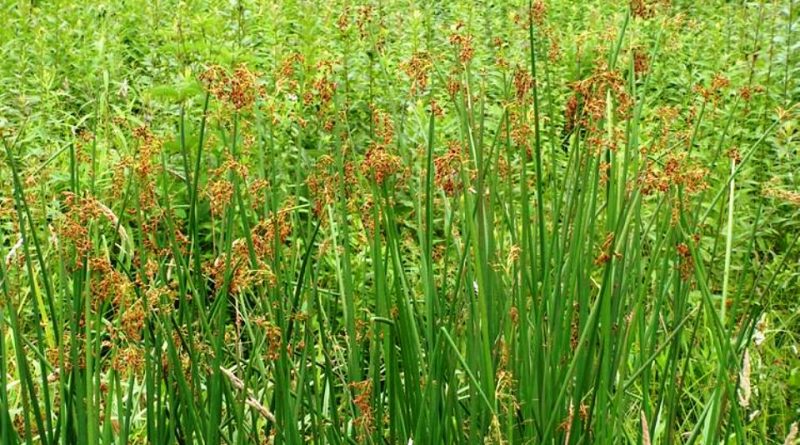Schoenoplectus tabernaemontani
Schoenoplectus tabernaemontani
Softstem bulrush or grey club-rush or great bulrush (Schoenoplectus tabernaemontani (C.C. Gmel.) Palla) is a herbaceous species belonging to the Cyperaceae family.
Systematics –
From a systematic point of view it belongs to:
Eukaryota Domain,
Kingdom Plantae,
Magnoliophyta Division,
Liliopsida class,
Cyperales Order,
Cyperaceae family,
Genus Schoenoplectus,
S. tabernaemontani species.
The terms are synonymous:
– Schoenoplectus lacustris subsp. glaucus (Hartm.) Bech .;
– Scirpus lacustris subsp. glaucus Hartm .;
– Scirpus lacustris subsp. tabernaemontani (C.C. Gmel.) Syme;
– Scirpus glaucus Sm., Nom. illeg.;
– Scirpus tabaernemontani C.C. Gmel.
Etymology –
The term Schoenoplectus comes from the Greek σχοινός schoinós rush (Latinized in schoenus) and from πλεκτός plectόs twisted, twisted, intertwined: twisted rush.
The specific epithet tabernaemontani was dedicated to Jakobi Theodori Müller (1515 / 20-1590), a doctor in Heidelberg and author of a botanical work of great historical importance. The Latinized name Tabernaemontanus derives from the German translation of Bergzabern in the Palatinate, his birthplace.
Geographic Distribution and Habitat –
The Softstem bulrush is a Eurasian-Mediterranean species
The plant is reported in much of the world, including North America and other territories.
In Italy it is present in all regions (not found in recent times in Liguria).
Its habitat is that of humid and wet places and sometimes in shallow waters, along slow streams, banks and ditches, on muddy soils with strong fluctuations in the water level, below the mountain belt.
In some environments, due to the decrease in humid areas, it is however a threatened species.
Description –
Schoenoplectus tabernaemontani is a herbaceous species with a rather variable appearance, which explains the long list of synonyms that have been created over the years.
It is a perennial that produces dense stumps of many narrow erect stems reaching 1-3m in height.
The plant is formed from a system of rhizomes.
The leaves are mostly basal and have wide sheaths around the stems.
The inflorescence is formed by solitary spikelets or in groups of 2-3, oblong ovoids of 4-10 x 2-3.5 mm, with acute or obtuse apex. The glumes are brown or brown-purple from elliptic to 2.5-3 mm ovate.
The flowering period is: June – August.
The fruits are dark gray-brown achenes, ovoid or ellipsoid of 2-2.5 mm, plane-convex, narrowed in a 02, -0.4 mm beak.
Cultivation –
Schoenoplectus tabernaemontani is a marsh plant consisting of a large rhizome.
The growth of this plant is slower than the other more common plants for phytoremediation.
The plant can be cultivated by arranging a planting depth between the rhizome and the water surface from 0 to -30 cm.
The plant should be grown in full direct sun for at least 6 hours a day and is resistant to very harsh temperatures.
A cultivar of this species with bright white or yellowish horizontal stripes, S. tabernaemontani ‘Zebrinus’, is sold as an ornamental plant for aquatic and landscaping gardens. Solid white and yellow cultivars are also available.
Customs and Traditions –
Schoenoplectus tabernaemontani is a plant that is also cultivated for ornamental purposes and for phytodepuration plants. It is a plant with high water purification efficacy, optimal both for ponds and bio-pools, and for phyto-purification plants. the plant is also used for food purposes. The new shoots and young roots can be eaten raw or cooked. Older roots can be turned into flour.
Preparation Method –
The rhizome of Schoenoplectus tabernaemontani is edible. The tender shoots and young roots of this plant are used in some parts of the world and eaten raw or cooked. The oldest roots are turned into flour.
Guido Bissanti
Sources
– Acta Plantarum – Flora of the Italian Regions.
– Wikipedia, the free encyclopedia.
– Useful Tropical Plants Database.
– Conti F., Abbate G., Alessandrini A., Blasi C. (ed.), 2005. An annotated checklist of the Italian vascular flora, Palombi Editore.
– Pignatti S., 1982. Flora of Italy, Edagricole, Bologna.
– Treben M., 2000. Health from the Lord’s Pharmacy, Advice and experiences with medicinal herbs, Ennsthaler Editore.
Warning: Pharmaceutical applications and alimurgical uses are indicated for informational purposes only, they do not represent in any way a medical prescription; therefore no responsibility is taken for their use for curative, aesthetic or food purposes.


